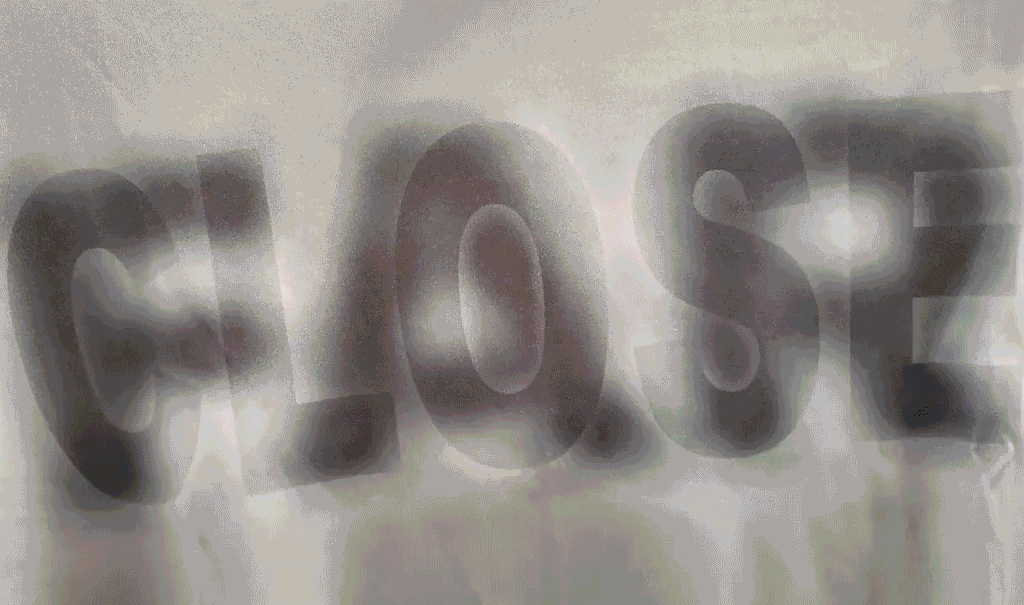
This incredible shirt says one thing when read by somebody standing next to you, but something else when they’re just a few meters away. Is it an illusion? Magic? Neither, really: it’s actually a special type of “hybrid image” that takes advantage of different spatial frequencies to work its wonder. Images are composed of elements that are viewed in different “spatial frequencies.” What’s the distinction? In general,
Low spatial frequencies:
- Show broad contours of the image, and whether areas are brighter or darker.
- Don’t look like much up close, but are easily interpreted by the brain from far away; you see the low spatial frequency elements of an image at distances over 3 meters or in your peripheral vision.
- When viewed on their own, the low spatial frequency parts of an image are basically a blurry, out-of-focus version of it.
High spatial frequencies:
- Are the sharp details and contours of an image, like the wrinkles of a face or texture of a fabric
- Predominate when you’re closer than .5 meters away and things are right in front of you. Studies in neuroscience shows that “right in front of you” means a narrow 12-14° band in the middle of your vision
- When you see only high spatial frequency parts of a picture, they look like a detailed line drawing, but without overall structure.
It’s all part of visual perception, that strange realm where the input from your eyes meets the functioning of your brain. The specific perceptual phenomenon at work here is known as “visuospatial resonance”: because your brain is trying to make sense of what it sees as quickly as possible, it takes the less-detailed information you see at a distance (low spatial frequency) and starts trying to fit those patterns into information stored in your memory. As you get closer and more of the high spatial frequency details emerge, the brain adds those to give you a fuller picture of what you’re seeing.
For example, when you see a person from farther away, you can identify their general shape, height, maybe even tell if the person is male or female, based on the low spatial frequency parts. As you get closer, the high frequency details emerge and you can tell if the person is smiling or frowning, and if they’re familiar, exactly who it is. By processing the visual data this way, your brain gives you a clue as to what you’re seeing as soon as possible, a process with a pretty obvious evolutionary benefit.

Up close, you'll see famous physicist Albert Einstein, but from afar Marilyn Monroe's face will begin to appear.
The hybrid image on your shirt works because most of the time your brain is good at putting all these pieces together so you see a complete image, but a hybrid image tricks the brain by pairing the low spatial frequency parts of one picture, with the high spatial frequency parts of another (in our case, two words).
Hybrid images were invented in their modern form in 1994, but the phenomenon has been known – at least to some people – for centuries. One example is Leonardo da Vinci, who used it in what is arguably the most famous painting in the world: the Mona Lisa!

The Livingstone Lab at Harvard separated out the different spacial frequencies of Mona Lisa's smile.
The Mona Lisa’s smile is famous because of how it seems to change depending on how you’re looking at it. For centuries, people have marveled that from a distance or to the side, the lady is smiling at you, but if you stand right in front of her the smile seems to disappear and she has a more neutral expression. Sound familiar? We now know that with his skills as one of the greatest painters of the Renaissance, Leonardo was able to imbue her with a smile based on different spatial frequencies. So the tip to seeing the Mona Lisa’s smile is to stand far away, or focus on her hands or the background so her mouth is in your peripheral vision. Then she’ll smile at you with the warmth of the Renaissance sun.
If you’d like to learn more about the world of hybrid images, there are a number of places to create them online (you can try this one), as well as continuing research to follow, like this study to see if you can put three images into a single picture using this technique. Let your curiosity be your guide!

